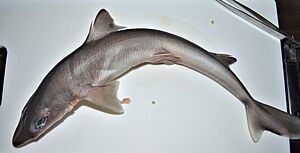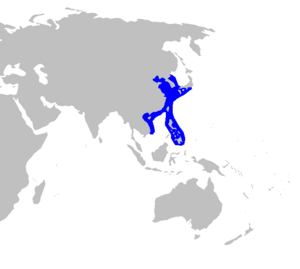Japanese spurdog facts for kids
Quick facts for kids Japanese spurdog |
|
|---|---|
 |
|
| Conservation status | |
| Scientific classification | |
| Genus: |
Squalus
|
| Species: |
japonicus
|
 |
|
| Range of the Japanese spurdog (in blue) | |
The Japanese spurdog (Squalus japonicus) is a type of dogfish shark. It belongs to the Squalidae family. You can find this shark in the western Pacific Ocean. It lives near southeastern Japan, the East China Sea, Republic of Korea, the Philippines, and the Arafura Sea. These sharks prefer cool and warm waters. They live along the edges of continents, called the continental shelf and slopes. Japanese spurdog sharks mainly eat other fish and squid. Sometimes, they get caught by accident when people are fishing for other things. This is called bycatch. Because of this, their numbers have gone down.
Contents
About the Japanese Spurdog
Male Japanese spurdog sharks grow to be about 50 to 70 centimeters (20 to 28 inches) long. Female sharks are a bit bigger. They can reach 56 to 80 centimeters (22 to 31.5 inches) in length. Females also weigh more than males. These sharks have many teeth. They have 25 to 27 teeth on their upper jaw. Their lower jaw has 20 to 24 teeth.
Where They Live
The Japanese spurdog lives in the Pacific Ocean. You can find them near southeast Japan, China, North Korea, South Korea, and Taiwan. There was also one time a Japanese spurdog was caught in the Arafura Sea. This sea is located between Australia and Western New Guinea. These sharks live near the bottom of the ocean. They are found on the continental shelf and upper slope. They can live in depths from 52 to 400 meters (170 to 1,312 feet).
Life Cycle and Reproduction
Japanese spurdog sharks give birth to live young. This is called viviparous. Each time they have babies, they give birth to 2 to 8 pups. The baby sharks are about 19 to 30 centimeters (7.5 to 11.8 inches) long when they are born. The mother shark carries her babies for 11 to 12 months. They can have babies every year. A study in the East China Sea found that there were equal numbers of male and female babies. The adult sharks also had an equal sex ratio.
Protecting the Japanese Spurdog
The Japanese spurdog is listed as Endangered on the IUCN Red List. This means they are at high risk of becoming extinct. In Japan, their numbers have stayed steady since 1983. However, in other places where they live, shark numbers have been dropping. This decline has been happening since the mid-1900s. Scientists believe that Japanese spurdog numbers have also gone down in these areas.
The biggest danger to these sharks is commercial fishing. Even though people don't usually fish for them directly, they often get caught by accident. This happens during bottom fishing, which is called demersal fishing. When they are caught, they are sometimes used for meat or fish meal.


